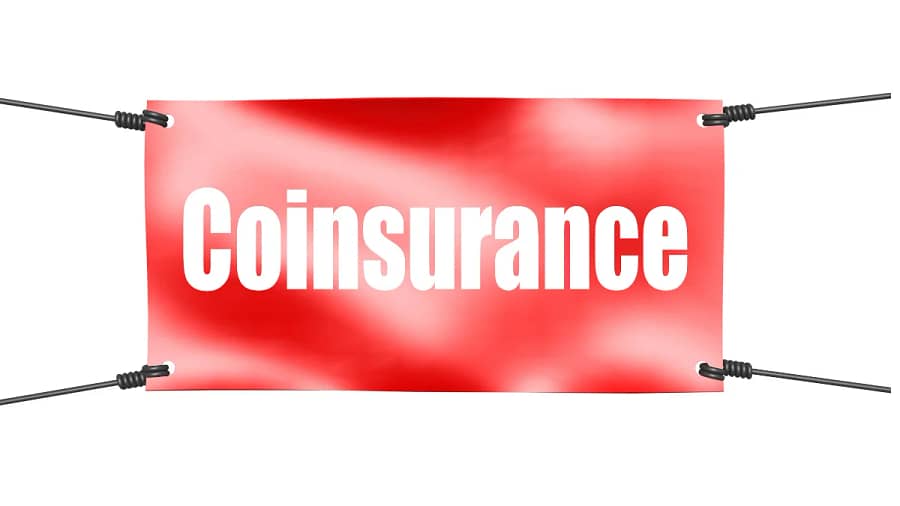


The insurance industry has many terms and jargon that common people are unfamiliar with. Coinsurance is one such term that is often confused with co-pay, deductible, out-of-pocket maximum, and more. Here’s a complete guide to help you understand coinsurance better.
Coinsurance involves sharing the cost of medical services between the insurance company and the policyholder. It is the percentage of the medical expense which the policyholder must pay after paying the deductible. The policyholder starts paying coinsurance only after the annual deductible has been paid. This means that they are responsible for paying medical expenses until the deductible has been reached. After that point, they can pay their coinsurance, which is a percentage of their medical expenses. The chosen insurance plan will cover the remaining eligible expenses up to the policy maximum or as outlined in the policy. The policyholder is obligated to pay the coinsurance only up to a specific limit called the out-of-pocket maximum, after which the insurance company covers 100% of the medical expenses up to the policy maximum.
Here’s an example to help you understand coinsurance better:
For instance, you have chosen an insurance plan which has a coinsurance of 80-20 for the first $5,000 and then 100% up to the chosen policy maximum. You have chosen a deductible of $1,000. Your out-of pocket maximum will be $2000 (20% of $5,000 and $1000 deductible). Say, you use the insurance and claims for medical expenses of $12,000.
You would first pay the deductible of $1,000, so from the remaining $11,000 in bills for the first $5000 your coinsurance would be $1,000 (i.e., 20% of $5,000) and the insurance company will first pay 80% of the first $5,000 which is $4,000 and then the remaining $6,000 which is 100% after coinsurance for the eligible claims.
For the further claims, as the deductible and co-insurance is now already met after the first claim, the insurance policy pays 100% up to the chosen policy maximum per the schedule of benefits.
Coinsurance is a fixed percentage that you pay toward the total cost of a medical bill after you have paid the deductible for the year. The insurance company also pays a percentage of your medical bill, which is generally more than that payment made by the policyholder. This percentage varies from one policy to another, but the most common percentage ratio that you will find are 90/10, 80/20, and 70/30.
Depending on the shared percentage, you pay a fixed amount, and your plan covers the rest of the charges up to the policy maximum. However, the coinsurance percentage can be different for in-network and out-of-network providers. Out-of-network coinsurance is usually higher than in-network coinsurance. In-network providers are medical providers with which your insurance plan has negotiated special rates, resulting in a lower coinsurance amount. All other medical providers are out-of-network providers and are generally more expensive, resulting in a higher coinsurance amount. Sometimes, the coinsurance percentage also varies for in-network and out-of-network providers. Suppose you pay 30% coinsurance for in-network medical expenses; you may be charged 50% coinsurance for out-of-network medical expenses. Some plans may not even cover out-of-network medical expenses.
A copay is a fixed fee that the policyholder pays to a doctor, clinic, or hospital for using their services. Generally, the amount is determined by your chosen insurance plan and is paid irrespective of the deductible being met. On the other hand, coinsurance is a fixed percentage that you pay on the total cost of the medical bill after you have paid your deductible. Your plan pays a higher percentage of the medical bill.
Services that typically require a copay include primary care and specialist doctor visits, physical, occupational, and speech therapies, prescription drugs, mental health services, urgent care, emergency room visits, etc. Depending on the plan, coinsurance can be applied to doctor visits, urgent care, procedures, hospitalizations, medications, etc.
Coinsurance is essential in health insurance due to the key benefits listed below:
While coinsurance offers you lower premiums, there are some drawbacks of coinsurance one must consider:
You pay coinsurance after you have hit your annual deductible.
No, both are different. Copay is a flat fee that you pay the doctor or specialist after taking their services. Coinsurance is a fixed percentage of the healthcare cost that you pay on the medical bills after paying the annual deductible.
For calculating your coinsurance, you must know your coinsurance rates, which varies from plan to plan. Coinsurance for services availed from in-network providers can vary from that of out-of-network providers.
30% coinsurance means that you will pay 30% of eligible medical expenses on the total medical bills after you have paid your annual deductible. The rest 70% will be covered by your insurance company.
Out-of-pocket maximum is the highest amount of money you are required to pay during a 12-month coverage period. If your annual out-of-pocket maximum is $5,000 and you have reached it, your plan will cover 100% of your covered health costs up to the chosen policy maximum during your coverage period.